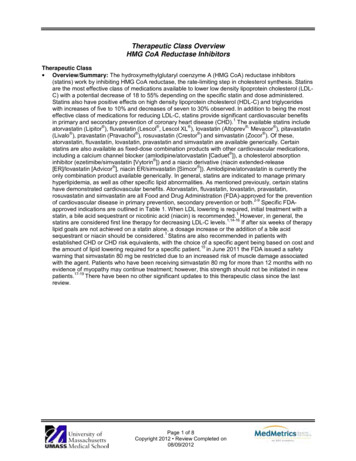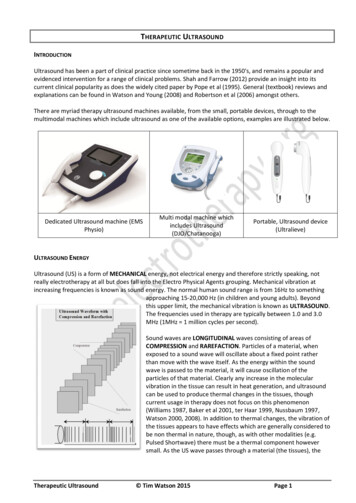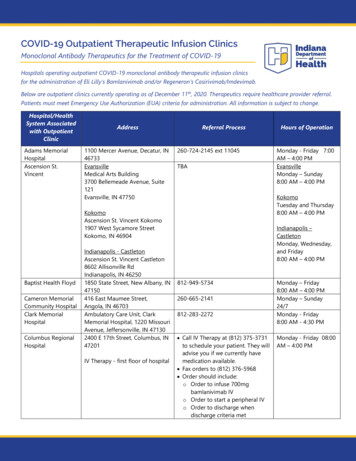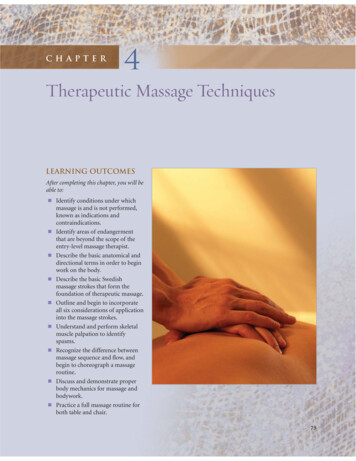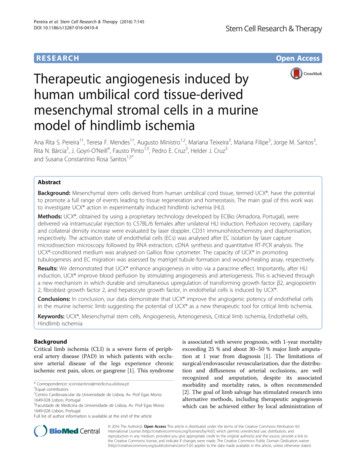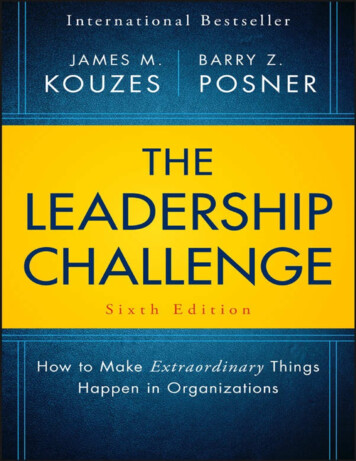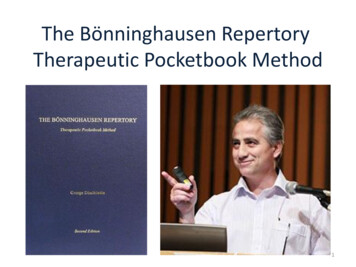
Transcription
The Bönninghausen RepertoryTherapeutic Pocketbook Method1
Samuel Hahnemann1813Hahnemann achieves great success treating typhoid feverThe year of 1813 was one oftriumph for Hahnemann. Thecontagious typhus fever, thetyphus of the camps, prevailedthroughout the length ofGermany. Hahnemann attendedcases of this terrible disease witha success that silenced his critics,and proved the superiority of thenew method and of the truth ofhis principle. From Bradford’s Lifeand Letters of Hahnemann2
Constantine HeringHering wrote many articles,monographs and books. It is in thesphere of drug provings, however, thatHering's effort shines at its best. It hasbeen remarked by Nash and others thatif Hering had done nothing else formedicine but the proving of the singledrug Lachesis, the world would owehim an everlasting debt of gratitude.Dr. Hering proved 72 drugs, out ofwhich the following are the most wellknown: Cantharis, Colchicum, Iodum,Mezereum, Sabadilla, Sabina, Psorinum,Nux moschata, Lachesis, Crotalus, Apis,Hydrophobinum, Phytolacca, Platina,Glonoin, Gelsemium, Kalmia, Ferrummet, Fluoric acid, and Phosphoric acid.1800 - 18803
Adolph LippeAdolph Graf zur Lippe-Weissenfield wasborn May 11, 1812 near Goerlitz, inPrussia, and died on January 23, 1888 inPennsylvania. In the fall of 1838 Lipperegistered in the first and onlyhomœopathic medical college in theworld, the North American Academy of theHomœopathic Healing Art in Allentown,Pennsylvania, also known as the AllentownAcademy. Afterward Lippe moved fromReading to Pottsville, PA in 1841 where hepracticed with success and growing abilityuntil 1844 when moving to Carlisle, PA.During this time, Dr. Lippe made a namefor himself with his treatment ofepidemics in the Cumberland Valley.1812-18884
Phineas Parkhurst WellsDr. Wells was one of the founders of theAmerican Institute of Homœopathy in 1844,and reluctantly a founder and first presidentof The International HahnemannianAssociation in 1881. He was the co-editor ofthe American Homœopathic Review from1862-66. Dr. Wells' own cure byBönninghausen in 1859 further galvanizedhis belief in Hahnemannian homœopathy.As a result of this experience Wells, next toAdolphe Lippe, became the most stalwartdefender and elucidator of Hahnemann'sprinciples. Wells' lectures on homœopathicpractice at the New York HomeopathicMedical College were highly esteemed, yethe declined their publication by hisenthusiastic students.1808 - 18915
Adolph Lippe1864Adolph Lippe becomes president of the Homœopathic MedicalCollege of Pennsylvania. In 1867 Constantine Hering leaves.Homœopathic Medical College of Pennsylvania - 1848 - Philadelphia6
The Therapeutic PocketbookRepertory (Taschenbuch)7
More than a Repertory!“The experience ofnearly a century hasverified the truth ofBönninghausen’s ideaand enabled us, in theuse of his masterpiece,The TherapeuticPocketbook, toovercome to a greatextent the imperfectionsand limitations of ourmateria medica.”Stuart Close, MD 1860 – 19298
The Bönninghausen RepertoryTherapeutic Pocketbook Method9
Other Books by Dimitriadis10
On-Line Course by Dimitriadis11
History of the RepertoryDevelopment and Utilization12
What is a Repertory?The word ‘repertory’ is derived from the LatinRepertorium, and means a place (storehouse,treasury, repository) in which things are placedso they can be easily found, as an index of a book.13
Is a Repertory necessary?“May the devil take allthe repertories. Theydestroy that whichbelongs together andunites points, which areforeign to each other,only for the sake ofadhering to the A, B, Cof Children’s readingbooks.”Julius Aegidi M.D.14
Hahnemann - the Repertory“For the convenience oftreatment, we require, merelyto jot down after eachsymptom all the medicineswhich can produce such asymptom with tolerableaccuracy, expressing them bya few letters and also to bearin mind the circumstancesunder which they occur ”Preamble to Materia Medica Pura15
J. T. Kent – the Repertory“True, some men dosome good workwithout the repertory,but they also do poorwork, more than theywould do with it.”James Tyler Kent M.D16
George Vithoulkas - Repertory“The repertory has alwaysbeen an indispensable toolin my practice. The absenceof books on the desk mayindicate experience andknowledge in many otherprofessions. For ahomeopath it only provesignorance.”Foreword to Synthesis 7,George Vithoulkas17
Limits of the RepertoryA repertory is never an end in itself. It is theduty of the physician to go back to the materiamedica and establish an actual connection.18
Limits of the RepertoryDifferent repertories each provide a unique planof construction. It is said that each one has itsown scope and limitation. None are perfect!19
Limits of the RepertoryCyrus Boger pointed outthat “Every repertory isuseful, unfortunately noone is complete”. Materiamedica is ever enlarging.Every day there are newclinical experiences andinformation from newprovings being added.20
Clemens Von Bönninghausen1846The Therapeutic Pocket Book - Clemens Von Bönninghausen21
Clemens Von BönninghausenDr. Bönninghausen was born to one of theoldest noble families of Westphalia,Germany. His full name was Clemens MariaFranz Baron Von Bönninghausen. He wasBaron by inheritance, a lawyer byprofession, and an agriculturist by naturalinclination. He held respected andresponsible posts in Germany includingauditor and privy council of the King,general secretary of the taxes, RoyalLibrarian, treasurer of the pensions andhead of the Topographical Institutes. As aDoctor of Law, Dr. Bönninghausen practicedas a lawyer for some time and later becamea judge. Because of his interest inhorticulture, he was made Director ofBotanical Gardens at Munster. Here, hecame to be known as the "Sage of Munster."1785-186422
History of RepertoriesHahnemann first attempted tocreate a repertory, adding analphabetical index to hisFragmenta de viribusMedicamentorum Positivis Sive inSano Humanis Corpore Observatispublished in 1805, andundertaking to furthercompilations – Hahnemann’sSymptomen-Lexikon (symptomregister) in 1817.23
History of RepertoriesHahnemann mentions in a correspondence toBönninghausen - “Sixteen years ago I produced asymptom-lexicon of the then proven remedies.”24
History of Repertories“My repertory was only analphabetical register, which couldat best provide service whenlooking for the particular remedysymptoms. And my [repertory]does not provide thiscompleteness yet.”“ but this register was not ascomplete as I wished it to be,since the symptoms according tocircumstances [modalities] havebeen mostly missed out ”25
History of RepertoriesHahnemann was not satisfied with these works,all of which remained unpublished. The originalHahnemann manuscripts can be viewed at theRobert Bosch Museum in Stuttgart, Germany.26
History of RepertoriesHahnemann employed E.F. Rückert to produce aRepertorium of antipsoric remedies to formvolume 5 of his 1st edition of Chronic Diseases.27
History of RepertoriesThere followed a number of worksby Hartlaub, Schweikert, Weber,and Rückert. Each listing a singleremedy alongside a singlesymptom, more or less as itappeared in the record. Thesewere not really repertories but alisting which would facilitatereference to the symptoms.Carl G. C. Hartlaub (1826 – 1830)Georg A. B. Schweikert (1828 – 1830)Georg A. Weber (1830)Ernst F. Rückert (1830 – 1832)28
History of RepertoriesBönninghausen began tostudy Homœopathy in 1928and quickly realized the needto index the symptoms of ourmateria medica, producing asuccession of works thatwere the direct precursors ofhis 1832 SystematicAlphabetical Repertory ofAntipsoric Remedies (SRA).29
Clemens von Bönninghausen1832Systematic Alphabetical Repertory of Antipsoric RemediesThe first homœopathic repertory approved by Hahnemann.Clemens von Bönninghausen30
History of RepertoriesWithin this work,Bönninghausen separatedthe consistent elements ofeach proving symptom andrendered them in rubric form,arranged systematically andalso alphabetically, and thenincorporated a consistent4-tier remedy grading systemto indicate the frequency ofclinical usefulness.31
Grading of RemediesIn the preface to the firstedition of Bönninghausen’sSRA, Bönninghausen writes“Moreover, it has been myendeavor to constantlyindicate symptoms that havebeen verified in practice, andI have sought to make thisperspicuous by use of adifferentiating type; ”32
Grading of RemediesThe system of gradingwas taken directlyfrom Hahnemann’sdesignation ofsymptoms in themateria medica.(doubtful)Plain typeBold type33
Grading of RemediesIn Bönninghausen’s repertories, the bracketed entriesindicate uncertainty as to whether or not thesymptom (represented by that rubric) is characteristicfor that remedy – all other entries indicatecharacteristics. Clinical frequency will apply to thegrade 3 (lowest) to grade 4 (highest). This 4-tiergrading system is consistently maintained fromBönninghausen’s first repertory to his last includingthe Therapeutic Pocketbook Repertory.34
Grading of Remedies() doubtful of being a characteristic1 - characteristic but only seen in one or a veryfew provers2- characteristic and seen in a few or manyprovers3- verified in clinical practice4- verified repeatedly in clinical practice35
History of RepertoriesWithin this work,Bönninghausen separatedthe consistent elements ofeach proving symptom andrendered them in rubric form,arranged systematically andalso alphabetically, and thenincorporated a consistent4-tier remedy grading systemto indicate the frequency ofclinical usefulness.36
Provings – the Foundation!Bönninghausen’s care toinclude only remedies with athorough proving is evidencedwhen he writes in the prefaceto SRA: “Ammoniummuriaticum, another remedytaught by Hahnemann as anantipsoric, has, alas as far as Iknow not yet been proven,and for this reason could notbe accepted ”37
Aphorism 108Therefore there is no other possible way to unerringlyexperience the peculiar actions of medicines upon the humancondition-there is no single, surer, more natural arrangement forthis intent than to administer each single medicineexperimentally, in a moderate amount, to healthy persons inorder to learn what alterations, symptoms and signs of itsimpinging action each medicine particularly brings forth in thecondition of body and soul, that is, what disease elements eachmedicine is able to and tends to arouse. As has been shown(§24-§27), all of a medicine's curative power lies in its power toalter the human condition; this is illuminated from observationof the human condition.38
History of Repertories“In order to render the available material really usefulto physicians, your repertory compiled with untoldlabor, would indeed be of great use to the world if youcould make up your mind to issue it in print. You wouldrender invaluable service to the homœopathicphysicians, who have neither the time nor the intellectto compile anything similar for themselves. I wouldurge you not to let your great modesty deter you fromthis. I ask you in the name of suffering humanity ”Letter from Hahnemann to Bönninghausen - March 16, 183139
History of RepertoriesThe SRA was very wellreceived by the profession,and a 2nd edition waspublished the very next year.In 1835 Bönninghausenpublished the SystematicAlphabetical Repertory ofHomeopathic Remedies, PartTwo (SRN) containing the“non-antipsoric” remedies.40
History of RepertoriesThe first edition of the SRA sold out within 6months. Hahnemann considered the work ofBönninghausen in high regard, and, in a letterdated Nov. 25, 1833, praised Bönninghausen.I hope they don’tsell out of the SRA41
History of RepertoriesIn a letter to Bönninghausen dated May 22,1835, Hahnemann writes “With pleasure andadmiration for your diligence regarding the workof the apsoric remedies I receive this secondpart of your repertory, and I thank you.”Thank you so much, Clemens –you are my best student!42
History of RepertoriesAs we read in the footnote of Aphorism 235from The Organon der Heilkunst:“Dr. von Bönninghausen, who has renderedmore services to our beneficent system ofmedicine than any of my other disciples, hasbest elucidated this subject, which demands somuch care, and has facilitated the choice of theefficient remedy for the various epidemics offever.”43
History of RepertoriesHahnemann had repeatedly encouraged Bönninghausen tocombine the SRA/SRN into a single volume, as we read in thefollowing letters to Bönninghausen:“I really want to see your repertory in one volume at some timein the future without discriminating the antipsorics from theothers!” Letter from October 23, 1840“I beg you again, if it would be possible, to publish both volumesof your repertory into one.” Letter from May 27, 1841“I notice with much delight that you are working so diligently onyour repertory in order to finish it.” Letter from September 24,184244
Repertory Lineage ChartTBR2 Pg. 645
History of RepertoriesThe origins of our modern dayrepertories stem from theoriginal works ofBönninghausen. But this hasnot been previously known asevidenced even from C.M.Boger, himself a notabledevotee of Bönninghausen’sworks, including theTherapeutisches Taschenbuch46.
History of RepertoriesBönninghausen did undertake this task, but stopped when he realized abetter reportorial method, the Therapeutic Pocketbook Repertory.“ it was at first my intention to retain the form and arrangement of myoriginal repertory, which Hahnemann repeatedly assured me, he preferred toall others: at the same time I intended to compress it into one volume, todefine every part of it with greater accuracy and to complete it as much aspossible from analogy as well as from experience. Having, however, finishedabout half of the manuscript, it had, contrary to my expectation, grown tosuch a size, that I the more willingly relinquishe
Preamble to Materia Medica Pura 15 . J. T. Kent – the Repertory Tue, some men do some good work without the repertory, but they also do poor work, more than they would do with it. _ James Tyler Kent M.D 16 . George Vithoulkas - Repertory The epetoy has always been an indispensable tool in my practice. The absence of books on the desk may indicate experience and knowledge in many other .
